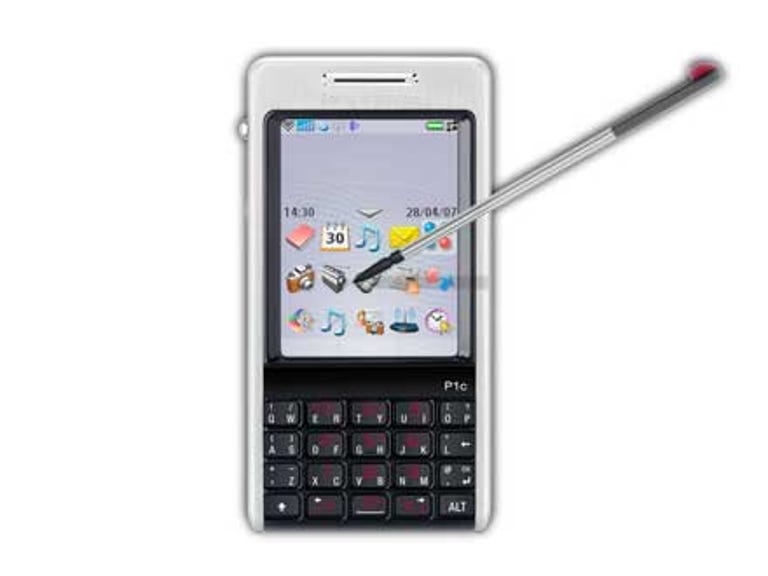 Why You Can Trust CNET
Why You Can Trust CNET Sony Ericsson P1i review: Sony Ericsson P1i
The P1i has most of the bells and whistles a business user could want, but the user interface is a little quirky.
Design
The P1i is the latest in Sony Ericsson's P-series range of business mobile phones. The newest incarnation in the P-series bears very little resemblance to its predecessors -- the P900 and P900i with their flip-lid form factor. The P1i sports a dual QWERTY keypad, weighs in at little under 125 grams and measures a sleek 106mm by 55mm by 17mm in dimension.
The Good
The Bad
The Bottom Line
The bulky look of the P-series phones has been retired with the new P1i. The P1i looks more like its cousin the M600i and comes in a brushed metal housing and a glossy plastic finish on the front. The P1i has two cameras, a 3.2 megapixel camera at the back of the phone and a second camera on the front for video calls.
On the left side of the phone is a Blackberry style jog-dial and a back button. On the right side of the phone is a shortcut button for the Web browser and a button for the camera, as well as a memory expansion slot that takes a Memory Stick micro card. The phone itself is bundled with a 512MB Memory Stick micro card for additional storage.
Aside from the improvement in form factor and size, the P1i also had increased internal memory (160MB) when compared to the previous models in the P-series. The responsiveness of the user interface on the P1i can be attributed to this increase in internal memory.
Features
The 2.6-inch QVGA touchscreen on the P1i supports a native resolution of 320x240 pixels. The transflective screen makes it easy to view in well-lit conditions as well as under direct sunlight.
The dual QWERTY keypad isn't the easiest to adapt to and does require a bit of getting used to. Data entry using the keypad is made somewhat simpler by the curved keys that rock sideways. Rocking the key to the left inputs one character while rocking it to the right inputs another. Holding down the key on the keypad facilitates numeric entry. This is not really the ideal way to input data, particularly for people with fat fingers. Although the P1i also has an onscreen keyboard, the keys on it are rather small and require almost laser-guided precision when tapping away with the stylus.
Intended primarily for business use, the P1i includes an office productivity suite with support for mobile versions of Microsoft Word and Excel, as well as a PDF reader. Office tools on this phone also include very interesting business card scanning software. It uses the camera to snap a picture of a business card and then makes use of text recognition to process the captured image to save details to the address book. In our tests, the business card scanner worked with limited accuracy. But on the plus side, the software attaches the captured image of the business card to a contact on the phone, which makes correction and reference to the business card later possible.
The 3.2 megapixel camera takes good quality pictures and has an LED for taking pictures in dark places. It is auto focusing and supports both micro and macro modes for taking pictures. The camera also does a very decent job of capturing video.
Opera, the browser of choice in most modern day phones, provides a pleasant Web browsing experience with quick page rendering times and a snappy user interface.
Multimedia features on the P1i include an FM radio and a music and video player, with support for video streaming over the Internet. Although the P1i has stereo audio output, the headsets use a proprietary connector. The headset doubles as aerial for FM radio.
Connectivity
The P1i supports Wi-Fi (802.11b), 3G, Bluetooth and infrared connectivity, although it certainly isn't the fastest phone in terms of data transfer. It does not support the faster 802.11g Wi-Fi protocol (54Mbps) and lacks HSDPA connectivity. It does however have Bluetooth 2.0 connectivity with EDR, support for Bluetooth networking and A2DP. A2DP enables stereo sound output when connected to external Bluetooth speakers or headsets.
Software on this device includes a third party ActiveSync client that enables push e-mail over Microsoft Exchange, and it lets users sync contacts and calendar items with their company's exchange server.
The connection manager software on the phone allows users to prioritise data connections. For instance, the Wi-Fi connection can be given a higher priority over the 3G, which means that the phone would choose to route Internet data over a Wi-Fi connection rather than 3G, when active Wi-Fi and 3G connections are both available. This is particularly useful for users on capped or smaller 3G data plans.
Performance
The P1i has a very fast and responsive interface, although it is quirky and requires a bit of getting used to. For instance when you click on "Read new message or e-mail", it doesn't take you straight into the message. It first opens up the Inbox and then a second later takes you into the message, displaying its contents. This makes the interface on the phone seem slower than it actually is. Also, we were only able to search through the contact list by typing in a contact's last name; searching using a contact's first name didn't seem to yield any results.
We are not entirely sure if it was just an issue with our particular review unit, but the call sound quality wasn't the greatest. The sound from the earpiece wasn't very clear when the in-call volume is set above the half way mark.
A full charge with occasional Web surfing and checking of e-mails gave us just under three days of battery life, while a fully charged battery drained itself out in little over a day and a half with push e-mail turned on.
